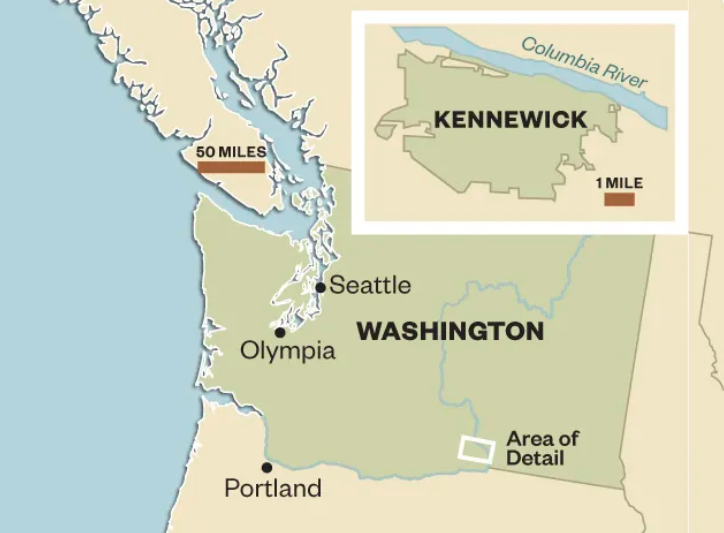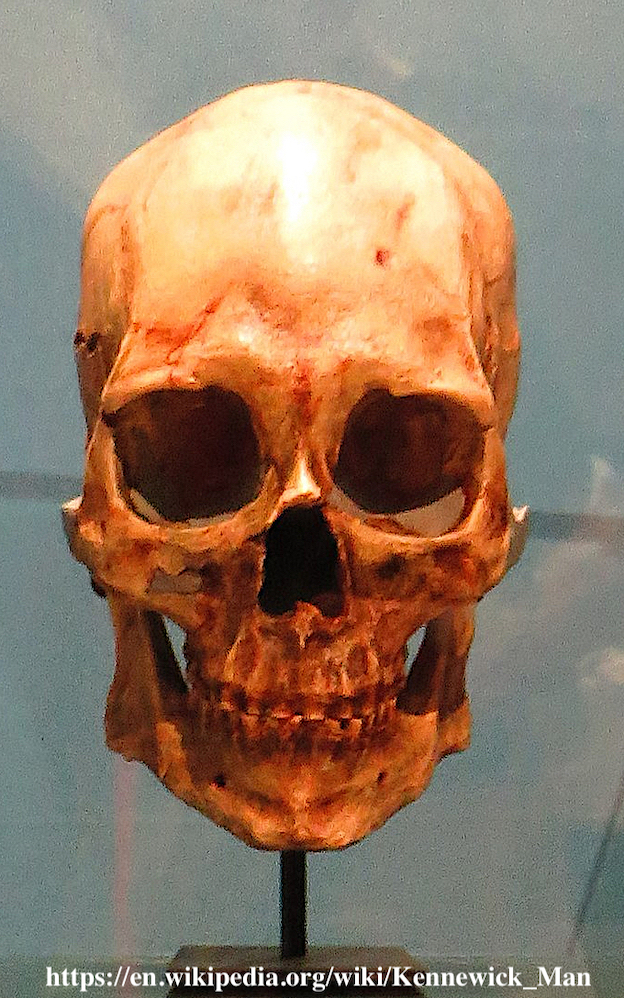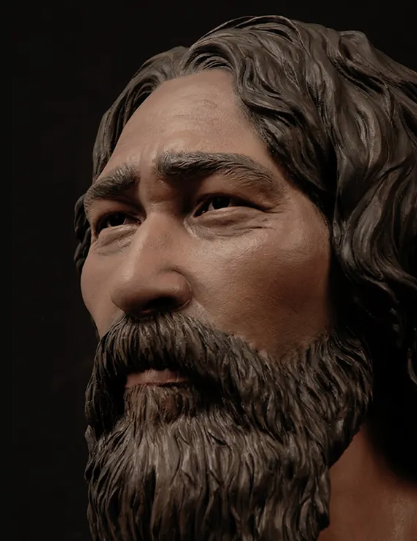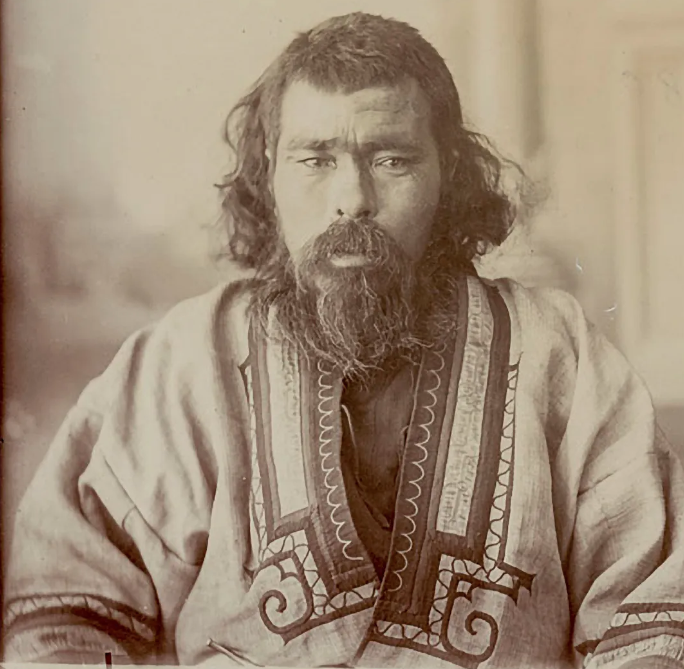


ケネウィク・マン
Kennewick Man
☆ ケネウィック・マンまたはエンシェント・ワン[=返還を要求したウマティラ族の呼称]は、1996年7月28日にワシントン州ケネウィックのコロンビア川岸で打ち上げられた骨格が発見された古インディアンである。放射性炭素分析による と、この人物は現在から約8900年~9000年前に生きていたことが判明しており、彼の骨格はアメリカ大陸でこれほど古い時代に発見されたものとしては 最も完全なもののひとつであり、アメリカ大陸の人口を理解する上で科学的に高い関心を集めている。
| Kennewick Man or Ancient One[nb
1] was a Paleo-Indian whose skeletal remains were found washed out on a
bank of the Columbia River in Kennewick, Washington, on July 28, 1996.
Radiocarbon tests show the man lived about 8,900 to 9,000 years before
present, making his skeleton one of the most complete ever found this
old in the Americas, and thus of high scientific interest for
understanding the peopling of the Americas.[1][2][nb 2] The discovery precipitated a nearly twenty-year-long dispute among three entities: Native American tribes that asserted rights to rebury the man under the federal Native American Graves Protection and Repatriation Act (NAGPRA), a law which protects Indian remains from disrespectful treatment, such as storage in labs, museums, and private collections.[4] The United States Army Corps of Engineers, that holds legal jurisdiction over the land where the remains were found. Finally the scientists who wanted to conduct further research on the skeleton. The archaeologists who made preliminary studies, James Chatters and Douglas Owsley, asserted he was only distantly related to today's Native Americans and more closely resembled Polynesian or Southeast Asian peoples, a finding that would exempt the case from NAGPRA. Technology for analyzing ancient DNA had been improving since 1996, and in June 2015 scientists at the University of Copenhagen announced that Kennewick Man is a genetic ancestor of Native Americans, including the Confederated Tribes of the Colville Reservation, the region where the bones were found.[5] In September 2016, the US House and Senate passed legislation to return the remains to a coalition of Columbia Basin tribes. The Ancient One was buried according to Indian traditions on February 18, 2017, with 200 members of five Columbia Basin tribes in attendance, at an undisclosed location in the area.[6] Within the scientific community since the 1990s, arguments for a non-Indian ancient history of the Americas, including by ancient peoples from Europe, have been losing ground in the face of ancient DNA analysis.[7] Kennewick Man symbolically marks an "end of a [supposed] non-Indian ancient North America".[7] [6] "Tribes lay remains of Kennewick Man to rest". The Spokesman-Review. Spokane, Washington. February 20, 2017. |
ケ
ネウィック・マンまたはエンシェント・ワン[nb
1]は、1996年7月28日にワシントン州ケネウィックのコロンビア川岸で打ち上げられた骨格が発見された古インディアンである。放射性炭素分析による
と、この人物は現在から約8900年~9000年前に生きていたことが判明しており、彼の骨格はアメリカ大陸でこれほど古い時代に発見されたものとしては
最も完全なもののひとつであり、アメリカ大陸の人口を理解する上で科学的に高い関心を集めている[1][2][nb 2]。 この発見は、3つの主体による20年近くに及ぶ論争を引き起こした: インディアンの遺骨を、研究所や博物館、個人コレクションでの保管といった無礼な扱いから保護する法律である連邦法NAGPRA(Native American Graves Protection and Repatriation Act)に基づき、埋葬し直す権利を主張したネイティブ・アメリカンの部族[4]、遺骨が発見された土地の法的管轄権を持つアメリカ陸軍工兵隊[5]。最 後に、この骸骨についてさらなる研究を行おうとする科学者たち。予備調査を行った考古学者、ジェームズ・チャターズとダグラス・オウスリーは、この骸骨は 現在のアメリカ先住民とは遠縁にすぎず、ポリネシアや東南アジアの人々に近いと主張した。 古代のDNAを分析する技術は1996年以来向上しており、2015年6月にコペンハーゲン大学の科学者たちは、ケネウィック・マンが骨が発見された地域であるコルビル居留地の連合部族を含むネイティブ・アメリカンの遺伝的祖先であると発表した[5]。2016年9月、アメリカの上下院はコロンビア盆地の部族連合に遺骨を返還する法案を可決した。エンシェント・ワンは2017年2月18日、コロンビア流域の5部族のメンバー200人が参列し、地域の非公開の場所にインディアンの伝統に従って埋葬された[6]。 1990年代以降の科学界では、ヨーロッパからの古代人を含むアメリカ大陸の非インディアン古代史の主張は、古代のDNA解析の前に根拠を失いつつあった[7]。ケネウィック・マンは象徴的に「(これまで想像されたような)古代北米人の非インディアン起源説の終焉」を示している[7]。 [6] "Tribes lay remains of Kennewick Man to rest". The Spokesman-Review. Spokane, Washington. February 20, 2017. |
| Discovery Kennewick Man was discovered by accident by two college students Will Thomas and David Deacy, on July 28, 1996. They were at the Columbia River to watch a hydroplane race near Kennewick. Thomas was wading in about 18 inches of water, about 10 feet from shore, when his foot struck something hard and round. He pulled up a human skull. They stashed it in the bushes, waited for the race to finish, then found a plastic bucket and took the skull to a Kennewick police officer. The police returned with the students to the location.[8] After further searching more bones were found underwater, and along the shore. The county coroner determined the skull was not modern, and it was given to archaeologist James Chatters, who over the course of ten visits to the site, assembled 350 bones and bone fragments creating a nearly complete articulated skeleton.[9] |
発見 ケネウィック・マンは、1996年7月28日、2人の大学生ウィル・トーマスとデビッド・ディーシーによって偶然発見された。彼らはケネウィック近郊のコ ロンビア川でハイドロプレーンのレースを観戦していた。トーマスが岸から10フィートほど離れた水深18インチほどのところでウェーディングをしていたと き、彼の足が硬くて丸いものにぶつかった。彼は人間の頭蓋骨を引き上げた。彼らはそれを茂みに隠し、レースが終わるのを待ち、プラスチックのバケツを見つ け、ケネウィック警察の警官のところに頭蓋骨を持っていった。さらに捜索を続けた結果、水中と海岸沿いでさらに多くの骨が発見された[8]。郡検視官はこ の頭蓋骨が現代のものではないと判断し、考古学者ジェームズ・チャターズに渡された。チャターズは10回にわたってこの場所を訪れ、350の骨と骨片を組 み立てて、ほぼ完全な関節のある骨格を作り上げた[9]。 |
| Scientific analysis Description The cranium was fully intact including all of its teeth from the time of death.[10] All major bones were found except the sternum and a few in the hands and feet.[11] After further study, Chatters concluded it was "a male of late middle age (40–55 years), and tall (170 to 176 cm, 5′7″ to 5′9″), and was fairly muscular with a slender build".[10] The Owsley team in 2005 reported he may have been as young as 38 at the time of death.[3] A small bone fragment submitted to the University of California, Riverside for radiocarbon dating estimated he lived between 9,300 and 9,600 years ago (8,400 uncalibrated "radiocarbon years"), and not the 19th century, as had originally been thought.[9] Subsequent radiocarbon dating indicated a somewhat younger age of 8,900 to 9,000 cal years BP.[2][1] Geography Measurements of carbon, nitrogen, and oxygen isotope ratios in the bone collagen indicate that the man lived almost exclusively on a diet of marine mammals for the last 20 or so years of his life, and that the water he drank was glacial melt.[12] The closest marine coastal environment where this water could have been found during his lifetime was in Alaska. That, combined with the location of the find, led to the conclusion that the individual led a highly mobile, water-borne lifestyle centered on the northern coast.[1][13] Injuries Chatters found a 79 mm (3.1 in) stone projectile lodged in his ilium (part of the pelvic bone). There was new bone growing around it indicating a painful but old wound.[11] Chatters made a CT scan which determined the projectile was made from a siliceous gray stone with igneous (volcanic) origins.[11] The projectile, leaf-shaped, long, and broad, with serrated edges, fit the description of a Cascade point, characteristic of the Cascade phase from 12,000 to 7,500 years BP.[11] Forensic anthropologist Douglas Owsley, who later led the scientific team that examined Kennewick Man's skeleton in 2005, discovered that the bones in Kennewick Man's arms were bent. Owsley theorized that this was the result of powerful muscles built up over the course of a lifetime of hunting and spearfishing.[14] Kennewick Man was found to be right-handed, as the bones of the right arm are noticeably larger than the left. Owsley also found that Kennewick Man had arthritis in his right elbow, both of his knees, and several vertebrae but not severe enough to be crippling. Kennewick Man had suffered some trauma in his lifetime, which was evident by a fractured rib that had healed, a depression fracture on his forehead, and a similar indentation on the left side of the head, and a spear jab that healed.[15] |
科学的分析 骨格 頭蓋は死亡時からすべての歯を含めて完全に無傷であった[10]。胸骨と手足の一部を除くすべての主要な骨が発見された[11]。 [11]さらなる調査の結果、チャターズは「中年後期(40~55歳)の男性で、身長は170~176cm(5′7″~5′9″)、細身の体格でかなり筋 肉質であった」と結論づけた[10]。 カリフォルニア大学リバーサイド校に提出された放射性炭素年代測定のための小さな骨片から、彼が生きていたのは9,300年から9,600年前 (8,400年未校正の「放射性炭素年」)であり、当初考えられていた19世紀ではないと推定された[9]。その後の放射性炭素年代測定では、8,900 年から9,000年紀とやや若い年代が示された[2][1]。 地理 骨のコラーゲンに含まれる炭素、窒素、酸素の同位体比を測定した結果、この人物は生涯の最後の20年ほどの間、ほとんど海洋哺乳類だけを食べて生活してい たこと、そして彼が飲んだ水は氷河の雪解け水であったことが判明した[12]。このことは、発見された場所と相まって、この人物は北部の海岸を中心とした 移動性の高い水上生活をしていたという結論につながった[1][13]。 負傷 チャターズは、腸骨(骨盤の骨の一部)に79mm(3.1インチ)の石の弾丸が刺さっているのを発見した。その周囲には新しい骨が成長しており、痛みは あったが古い傷であったことを示していた[11]。チャターズはCTスキャンを行い、その発射体は火成岩(火山)を起源とする珪質灰色の石でできていると 断定した[11]。その発射体は葉の形をしており、長くて幅が広く、鋸歯状のエッジがあり、紀元前12,000年から7,500年までのカスケード期に特 徴的なカスケード・ポイントの特徴に合致していた[11]。 後に2005年にケネウィック・マンの骨格を調査した科学チームを率いる法人類学者ダグラス・オーズリーは、ケネウィック・マンの腕の骨が曲がっているこ とを発見した。オースリーは、これは狩猟とスピアフィッシングの生涯を通じて鍛えられた強力な筋肉の結果であると推論した[14]。右腕の骨が左腕よりも 明らかに大きいことから、ケネウィックマンは右利きであることが判明した。 オウスレイはまた、ケネウィック・マンが右肘、両膝、いくつかの椎骨に関節炎を患っていることを発見したが、不自由になるほど重度ではなかった。ケネ ウィック・マンが生涯に何らかの外傷を受けていたことは、治癒した肋骨の骨折、額の窪み骨折、左側頭部の同様の窪み、治癒した槍の刺し傷によって明らかで ある[15]。 |
| Genetic and cultural origins Chatters, who initially investigated the skeleton, early on concluded that the "presence of Caucasoid traits [and a] lack of definitive Native-American characteristics", as well as the apparent context of the skeleton as part of an early Paleo-American group led him to state that the body was "Caucasian" (an anthropological term not synonymous with "white" or "European").[16][17] Scientists attempted DNA analysis within a few years of discovery, but reported "available technology and protocols do not allow the analysis of ancient DNA from these remains" ie. multiple experts were unable to extract enough DNA for analysis.[18] Chatters et al. (2000) conducted a graphic comparison, including size, of Kennewick Man to eighteen modern populations. They found Kennewick Man to be most closely related to the Ainu, a recognized indigenous people of Northern Japan. However, when size was excluded as a factor, no association to any population was established.[9] In 2001, Chatters wrote that the "craniofacial characteristics of Paleo-Americans, Asians, and early Europeans, loosely resemble the Ainu, Polynesian, and Australian peoples", but that no group was the major contributor to the Paleo-American gene pool.[19] Anthropologist C. Loring Brace maintained in a 2006 interview that, by his analysis, Kennewick Man was "likely related" to the Ainu of Japan.[20] Anthropologist Joseph Powell of the University of New Mexico was also allowed to examine the remains. Powell used craniometric data obtained by anthropologist William White Howells of Harvard University and anthropologist Tsunehiko Hanihara of Saga University; this had the advantage of including data drawn from Asian and North American populations.[21] Powell said that Kennewick Man was not European but most resembled the Ainu[9] and Polynesians.[21] Powell said that the Ainu descend from the Jōmon people, an East Asian population with "closest biological affinity with south-east Asians rather than western Eurasian peoples".[22] Powell said that dental analysis showed the skull to have a 94-percent consistency with being of a Sundadont group like the Ainu and Polynesians and only a 48-percent consistency with being of a Sinodont group like that of North Asia.[23] Powell said analysis of the skull showed it to be "unlike American Indians and Europeans".[23] Powell concluded that the remains were "clearly not a Caucasoid unless Ainu and Polynesians are considered Caucasoid".[22] Advances in genetic research made it possible to analyze ancient DNA (aDNA) more accurately than earlier attempts when the skeleton was found. In June 2015, new results concluded that the remains are more closely related to modern Native Americans than to any other living population. Kennewick Man's genetic profile was particularly close to that of members of the Confederated Tribes of the Colville Reservation. Of the five tribes that originally claimed Kennewick Man as an ancestor, their members were the only ones to donate DNA samples for evaluation. The lack of genomes from North American aboriginal populations have made it impossible to ascertain Kennewick Man's nearest living relatives among regional Native American tribes. His Y-DNA haplogroup is Q-M3 and his mitochondrial DNA is X2a, both uniparental genetic markers found almost exclusively in Native Americans.[24] Burial Kennewick Man had been buried deliberately.[3] By examining the calcium carbonate left behind as underground water collected on the underside of the bones and then evaporated, scientists were able to conclude that Kennewick Man was lying on his back with his feet rolled slightly outward and his arms at his side, with the palms facing down, a position that could not have been accidental.[25][26] |
遺伝的・文化的起源 最初にこの骨格を調査したチャターズは、「コーカソイドの形質が存在し(そして)ネイティブ・アメリカンの決定的な特徴がない」こと、またこの骨格が初期 の古アメリカン集団の一部であるという明白な文脈から、この遺体は「コーカソイド」(「白人」や「ヨーロッパ人」と同義ではない人類学用語)であると早い 段階で結論づけた[16][17]。 科学者たちは発見から数年以内にDNA分析を試みたが、「利用可能な技術とプロトコルでは、これらの遺体から古代のDNAを分析することはできない」、つまり複数の専門家が分析に十分なDNAを抽出することができなかったと報告している[18]。 Chattersら(2000年)は、ケネウィック人と18の現代人集団の大きさなどの比較を行った。彼らはケネウィック人が北日本の先住民族として知ら れているアイヌと最も近縁であることを発見した。2001年、チャターズは「古アメリカ人、アジア人、初期ヨーロッパ人の頭蓋顔面の特徴は、アイヌ人、ポ リネシア人、オーストラリア人に緩やかに似ている」と書いたが、どのグループも古アメリカ人の遺伝子プールの主要な貢献者ではなかった。 [19] 人類学者のC.ローリング・ブレイスは2006年のインタビューで、彼の分析によればケネウィック人は日本のアイヌと「関係がある可能性が高い」と主張し ている[20]。 ニューメキシコ大学の人類学者ジョセフ・パウエルも遺骨の調査を許可された。パウエルはハーバード大学の人類学者ウィリアム・ホワイト・ハウエルズと佐賀 大学の人類学者埴原恒彦によって得られた頭蓋測定データを使用した。 [21]パウエルは、ケネウィック人はヨーロッパ人ではなく、アイヌ人[9]とポリネシア人に最も似ていると述べた[21]。パウエルは、アイヌ人は「西 ユーラシアの人々よりもむしろ東南アジアの人々と生物学的に最も親和性が高い」東アジアの集団である縄文人の子孫であると述べた。 [22]パウエルは、歯の分析によって、頭蓋骨がアイヌやポリネシア人のようなスンダドント・グループのものであることとの整合性は94パーセントであ り、北アジアのようなシノドント・グループのものであることとの整合性は48パーセントに過ぎなかったと述べている[23]。パウエルは、頭蓋骨の分析に よって「アメリカ・インディアンやヨーロッパ人とは異なる」ことが示されたと述べている[23]。パウエルは、この遺骨は「アイヌやポリネシア人がコーカ ソイドとみなされない限り、明らかにコーカソイドではない」と結論付けている[22]。 遺伝子研究の進歩により、骨格が発見された以前の試みよりも正確に古代のDNA(aDNA)を分析することが可能になった。2015年6月、新たな結果に よって、この遺骨は現存するどの集団よりも現代のネイティブ・アメリカンに近縁であると結論づけられた。ケネウィックマンの遺伝子プロファイルは、特にコ ルビル居留地連合部族のメンバーに近かった。ケネウィック・マンを祖先と主張する5部族のうち、評価のためにDNAサンプルを提供したのは彼らのメンバー だけであった。北米原住民のゲノムが不足しているため、ケネウィック・マンに最も近縁のアメリカ先住民の部族を確認することは不可能であった。彼のY- DNAハプログループはQ-M3であり、ミトコンドリアDNAはX2aである。 埋葬 ケネウィック・マンは意図的に埋葬された[3]。地下水が骨の裏側に溜まり、蒸発する際に残る炭酸カルシウムを調べることで、科学者たちはケネウィック・ マンは仰向けに横たわり、足をやや外側に倒し、両腕は手のひらを下に向けた状態で脇に置いていたと結論づけることができた。 |
| Scientific initiatives and significance Scientific initiatives There have been three major scientific initiatives to study and report on Kennewick Man. Between 1998 and 2000, the Department of the Interior and National Park Service, in cooperation with the Corps of Engineers, the federal agency responsible for the Kennewick remains, conducted a series of scientific examinations of the remains. Eighteen nationally and internationally recognized scientists and scholars conducted a variety of historical and scientific examinations, analyses, tests, and studies.[27] Nevertheless, the "analysis was quickly suspended by the U.S. government" because of the controversy over custodianship of the remains.[11] After the suspension of the government studies, anthropologists sued the government, and in 2002 won the right to study the bones. For the next six years beginning in 2005, Douglas Owsley of the Smithsonian Institute coordinated more than a dozen experts, who analyzed the bones in numerous ways including forensic anthropology, physical anthropology, and isotope chemistry. Their report was published in 2014, in the book titled Kennewick Man, The Scientific Investigation of an Ancient American Skeleton.[28] In 2015, the paper in Nature titled "The Ancestry and Affiliations of Kennewick Man" analyzed ancient DNA from Kennewick Man, and determined he is associated with modern day Indians.[5] Scientific significance According to Time magazine, "Scientists have found only about 50 skeletons of such antiquity, most of them fragmentary. Any new find can thus add crucial insight into the ongoing mystery of who first colonized the New World."[3] Since the mid-1990s within the science community, "Palaeoamericans" have vied with "Palaeoindians" over the identity of the first people of the Americas. "Palaeoamericans" posit the earliest inhabitants are not related to modern day Indians. "Palaeoindians" assert modern Indians are connected to the earliest settlers. Kennewick Man, and DNA from other ancient skeletons, has played a significant role in eroding the Palaeoamerican theory. Kennewick Man's DNA results mark an "end of a [supposed] non-Indian ancient North America".[7] The discovery of Kennewick Man, along with other ancient skeletons, has furthered scientific debate over the origin and history of early Native American people.[9] One hypothesis holds that a single source of migration occurred, consisting of hunters and gatherers following large herds of game who wandered across the Bering land bridge. An alternative hypothesis is that more than one source population was involved in migration immediately following the Last Glacial Maximum (LGM), which occurred ~22k to ~18k years BP, and that the land migration through Beringia was either preceded by or roughly synchronous with a waterborne migration from coastal Asia.[29] The similarity of some ancient skeletal remains in the Americas, such as Kennewick Man, to coastal Asian phenotypes is suggestive of more than one migration source.[how?][1][9][22][30] Classification of DNA from ancient skeletons such as Kennewick Man and others of similar phenotype may or may not reveal genetic affiliation between them, with either Beringian[31][32] or coastal Asian[33][34] source populations. Regardless of the debate over whether there were more than one source of migration following the LGM, Kennewick Man has yielded insight into the marine lifestyle and mobility of early coastal migrants.[13] Owsley study criticisms In 2012, Burke Museum archeologists voiced concern and criticism of the Owsley team's preliminary findings (not published fully until 2014). First, it was noted that no one outside of Owsley's team had an opportunity to examine the Smithsonian's data to see how the team reached its conclusions.[35] Second, the absence of peer-reviewed articles published prior to Owsley unveiling the bones' "secrets" was criticized.[35] Third, Owsley's non-Native argument hinged on the assumption that Kennewick Man's skull was a reliable means of assessing ancestry. This was a "nineteenth-century skull science paradigm", said David Hurst Thomas, a curator at the American Museum of Natural History.[36] Skulls are no longer used as the basis for classifying remains,[citation needed] as DNA evidence is more reliable. Racial issues In 2005, author Jack Hitt wrote an essay "Mighty White of You: Racial Preferences Color America's Oldest Skulls and Bones", in which he describes a systemic "racial preference" for Kennewick Man, and other old skeletons, to be of European origin. If this theory held true (and DNA evidence shows it does not), it would turn the tables on Indian claims of being the first inhabitants, white Europeans would be the victims of Indian invaders, and politically modern Indians would have less claim to sovereignty.[37] The use of the word "Caucasoid" to describe Kennewick Man, and his facial reconstruction that appeared plausibly European, were taken by many to mean that Kennewick Man was "Caucasian", European, or "white", rather than an ancestor of present-day Native Americans,[17] although the term "Caucasoid" had also been applied to the Ainu of northern Japan. In 1998, The New York Times reported "White supremacist groups are among those who used Kennewick Man to claim that Caucasians came to America well before Native Americans."[38] Additionally, Asatru Folk Assembly, a racialist neopagan organization, sued to have the bones genetically tested before it was adjudicated that Kennewick Man was an ancestor of present-day Native Americans.[38] |
科学的な取り組みと意義 科学的取り組み ケネウィック人を調査・報告するための3つの主要な科学的取り組みがある。 1998年から2000年にかけて、内務省と国立公園局は、ケネウィック遺跡の連邦責任機関である工兵隊と協力して、遺跡の一連の科学的調査を実施した。 18人の国内外で著名な科学者や学者が、さまざまな歴史的・科学的調査、分析、試験、研究を行った[27]。にもかかわらず、遺骨の管理権をめぐる論争の ために、「分析は米国政府によってすぐに中断された」[11]。 政府による研究が中断された後、人類学者は政府を訴え、2002年に骨を研究する権利を勝ち取った。2005年から6年間、スミソニアン研究所のダグラ ス・オーズリーは10人以上の専門家を調整し、法人類学、物理人類学、同位体化学など多くの方法で骨を分析した。彼らの報告書は2014年に 『Kennewick Man, The Scientific Investigation of an An Ancient American Skeleton』という本として出版された[28]。 2015年、『ネイチャー』に掲載された「ケネウィック・マンの祖先と所属」と題された論文は、ケネウィック・マンの古代のDNAを分析し、彼が現代のインディアンと関連していると断定した[5]。 科学的意義 タイム誌によれば、「科学者たちは、このような古代の骨格を50体ほどしか発見しておらず、そのほとんどは断片的である。したがって、新たな発見は、誰が最初に新大陸を植民地化したのかという現在進行中の謎に決定的な洞察を加えることができる」[3]。 1990年代半ば以来、科学界では、アメリカ大陸の最初の人々のアイデンティティをめぐって、「古アメリカ人」が「古インド人」と争ってきた。「古アメリ カ人」は、アメリカ大陸最古の住民は現代のインディアンとは無関係であると主張する。「古インド人」は、現代のインディアンは初期の入植者と関係があると 主張する。ケネウィック・マンと他の古代の骨格から採取されたDNAは、古アメリカ人説を否定する上で重要な役割を果たしている。ケネウィックマンの DNAの結果は、「インディアンではない(とされる)古代の北アメリカの終わり」を告げるものである[7]。 ケネウィックマンの発見は、他の古代の骨格とともに、初期アメリカ先住民の起源と歴史に関する科学的議論をさらに深めることになった。もう一つの仮説は、 最終氷期最盛期(LGM)直後の移動には複数の移動元集団が関与しており、ベリンギアを通過する陸上移動は、沿岸アジアからの水上移動に先行していたか、 ほぼ同期していたというものである[29]。 ケネウィック人のようなアメリカ大陸の古代の骨格が沿岸アジアの表現型と類似していることは、複数の移動源があることを示唆している[1][9][22] [30]。ケネウィック人のような古代の骨格や他の類似した表現型の骨格から採取したDNAを分類すると、ベリンギ人[31][32]または沿岸アジア人 [33][34]のいずれかの移動源集団との間の遺伝的関係が明らかになることもあれば、ならないこともある。 LGM後の移住源が複数存在したかどうかという議論にかかわらず、ケネウィック人は初期の沿岸移住者の海洋生活と移動に関する洞察をもたらした[13]。 オウスリー研究への批判 2012年、バーク博物館の考古学者たちは、オウスリーチームの予備調査結果(2014年まで完全には発表されなかった)に対して懸念と批判を表明した。 第二に、オーズリーが骨の「秘密」を明らかにする前に発表された査読付き論文がないことが批判された[35]。第三に、オーズリーの非ネイティブの議論 は、ケネウィックマンの頭蓋骨が先祖を評価する信頼できる手段であるという仮定にかかっていた。これは「19世紀の頭蓋骨科学のパラダイム」であったと、 アメリカ自然史博物館の学芸員デビッド・ハースト・トーマスは述べている[36]。 DNA証拠の方がより信頼できるため、頭蓋骨はもはや遺骨を分類する基準としては使われていない[要出典]。 人種問題 2005年、作家のジャック・ヒットは「マイティ・ホワイト・オブ・ユー」というエッセイを書いた: Racial Preferences Color America's Oldest Skulls and Bones "というエッセイを書き、ケネウィック・マンやその他の古い骸骨がヨーロッパ系であるという体系的な「人種的選好」について述べている。もしこの説が真実 であれば(DNAの証拠はそうではないことを示している)、インディアンが最初の住民であったという主張は覆され、白人のヨーロッパ人はインディアンの侵 略の犠牲者となり、政治的に近代的なインディアンは主権を主張することができなくなるだろう[37]。 ケネウィック・マンを表現するために「コーカソイド」という言葉が使われたこと、そして彼の顔の復元がもっともらしくヨーロッパ人に見えたことから、多く の人々はケネウィック・マンは現在のアメリカ先住民の祖先ではなく、「コーカソイド」、ヨーロッパ人、または「白人」であると受け取った[17]。 1998年、『ニューヨーク・タイムズ』紙は「白人至上主義者グループは、ケネウィック・マンを使って、アメリカ先住民よりもずっと前に白人がアメリカに 来たと主張する人々の中に含まれている」と報じた[38]。さらに、人種主義的な新異教徒組織であるアサトル・フォーク・アセンブリーは、ケネウィック・ マンが現在のアメリカ先住民の祖先であると裁定される前に、その骨を遺伝子検査するよう訴えた[38]。 |
| Custody of Kennewick Man In October 1998, the remains were deposited at the Burke Museum at the University of Washington. The Burke Museum was the court-appointed neutral repository for the remains, and did not exhibit them. They were then still legally the property of the US Army Corps of Engineers, as they were found on land under its custody.[39] According to NAGPRA, if human remains are found on federal lands and their cultural affiliation to a Native American tribe can be established, the affiliated tribe may claim them. Two months after discovery in 1996, the Umatilla tribe requested custody of the remains so they could be reburied according to tribal tradition. It was contested by researchers who believed Kennewick Man was not affiliated with modern Indians.[40] The Umatilla argued that their oral history goes back 10,000 years, and they had been present on the territory since the dawn of time.[41] Native American tribes asserted that the claims that Kennewick Man was of non-Indian origin was an attempt to evade the law governing custodianship of ancient bones. The Corps of Engineers and the Clinton administration supported the Native American claim in what became a long-running lawsuit.[42] Robson Bonnichsen and seven other anthropologists sued the United States for the right to conduct research. The anthropologists won the case in 2002, and on February 4, 2004, the United States Court of Appeals for the Ninth Circuit panel rejected an appeal brought by the United States Army Corps of Engineers and the Umatilla, Colville, Yakama, Nez Perce, and other tribes on the grounds that they were unable to show sufficient evidence of kinship.[43][44] Furthermore, the presiding judge found that the US government had acted in bad faith and awarded attorney's fees of $2,379,000 to the plaintiffs.[1] On April 7, 2005, during the 109th Congress, United States senator John McCain introduced an amendment to NAGPRA, which (section 108) would have changed the definition of "Native American" from being that which "is indigenous to the United States" to "is or was indigenous to the United States".[45] However, the 109th Congress concluded without enacting the bill. By the bill's definition, Kennewick Man would have been classified as Native American regardless of whether any link to a contemporary tribe could be found. Reburial In September 2016, in light of new DNA evidence associating Kennewick Man with modern day Indians, the 114th US House and Senate passed legislation to return the ancient bones to a coalition of Columbia Basin tribes. The coalition included the Confederated Tribes of the Colville Reservation, the Confederated Tribes and Bands of the Yakama Nation, the Nez Perce Tribe, the Confederated Tribes of the Umatilla Reservation, and the Wanapum Band of Priest Rapids.[46] The remains of Kennewick Man were cataloged and removed from the Burke Museum on 17 February 2017. The following day, more than 200 members of five Columbia Plateau tribes were present at a burial of the remains, according to their traditions, at an undisclosed location.[6][47] |
ケネウィック人の保管 1998年10月、遺骨はワシントン大学のバーク博物館に寄託された。バーク博物館は裁判所が任命した遺骨の中立的な保管場所で、遺骨を展示することはな かった。遺骨はアメリカ陸軍工兵隊の管理下の土地で発見されたため、法的にはまだアメリカ陸軍工兵隊の所有物であった[39]。 NAGPRAによれば、連邦政府の土地で遺骨が発見され、その遺骨がネ イティブ・アメリカンの部族と文化的なつながりがあることが証明された場合、その部族は遺骨を引き取ることができる。1996年の発見から2ヵ月後、ウマ ティラ族は部族の伝統に従って埋葬し直すため、遺骨の所有権を要求した。しかし、ケネウィックマンは現代インディアンとは無関係であると考える研究者たち によって、この要求は却下された。ウマティラ族は、彼らの口承の歴史は1万年前にさかのぼり、有史以来この地に存在していたと主張した[41] 。ネイティブ・アメリカンの部族は、ケネウィック・マンが非インディアン起源であるという主張は、古代の骨の所有権を管理する法律から逃れようとする試みであると主張した。工兵隊とクリントン政権は、長期にわたる訴訟においてネイティブ・アメリカンの主張を支持した。 [41] Thomas, David Hurst (2001). Skull Wars: Kennewick Man, Archaeology, and the Battle for Native American Identity. Basic Books. p. Preface: xxii. ISBN 978-0465092253. Our oral history goes back 10,000 years. We know how time began and how Indian people were created. They can say whatever they want, the scientists. They are being disrespectful.[pdf_with_password] ロブソン・ボニクセンと他の7人の人類学者は、調査を行う権利を求めてアメリカを訴えた。人類学者たちは2002年に勝訴し、2004年2月4日、第9巡 回区連邦控訴裁判所は、米国陸軍工兵隊とウマティラ、コルヴィル、ヤカマ、ネズパース、およびその他の部族が提起した控訴を、親族関係の十分な証拠を示す ことができなかったという理由で却下した[43][44]。さらに裁判長は、米国政府が不誠実に行動したと認定し、原告側に237万9000ドルの弁護士 費用を認めた[1]。 2005年4月7日、第109議会中、アメリカ合衆国上院議員ジョン・マケインは、「ネイティブ・アメリカン」の定義を「アメリカ合衆国に土着している」 から「アメリカ合衆国に土着している、または土着していた」に変更する修正案(第108条)をNAGPRAに提出した[45]。法案の定義では、ケネ ウィック・マンは現代の部族とのつながりの有無にかかわらず、ネイティブ・アメリカンに分類されるはずであった。 再埋葬 2016年9月、ケネウィック・マンと現代のインディアンとの関連を示す新たなDNA証拠を踏まえて、第114期米上下両院は古代の骨をコロンビア盆地の 部族連合に返還する法案を可決した。この連合には、コルヴィル居留地連合部族、ヤカマ民族連合部族およびバンド、ネズパース部族、ウマティラ居留地連合部 族、プリーストラピッズのワナパムバンドが含まれていた[46]。 ケネウィックマンの遺骨は、2017年2月17日に目録が作成され、バーク博物館から搬出された。翌日、コロンビア高原の5部族の200人以上のメンバーが、非公開の場所で、彼らの伝統に従って遺骨の埋葬に立ち会った[6][47]。 |
| Archaeology of the Americas Archeological sites Calico Early Man Site Fort Rock Cave Marmes Rockshelter Mummy Cave Paisley Caves Cueva de las Manos – (Cave paintings) Genetic history of indigenous peoples of the Americas Human remains Anzick-1 Arlington Springs Man Buhl Woman Kwäday Dän Ts'ìnchi Leanderthal Lady Luzia Woman Naia Windover Archaeological Site List of unsolved deaths Repatriation and reburial of human remains Settlement of the Americas |
アメリカ大陸の考古学 遺跡 カリコ・アーリーマン遺跡 フォートロック洞窟 マーメス・ロックシェルター ミイラ洞窟 ペイズリー洞窟 クエバ・デ・ラス・マノス(洞窟壁画) アメリカ大陸先住民の遺伝史 人骨 アンジック-1 アーリントン・スプリングス・マン ブール女性 クウェデイ・ダン・ツィンチ レアンデルタール女性 ルジア 女性 ナイア ウィンドオーバー遺跡 未解決死亡者リスト 人骨の埋葬と再埋葬 アメリカ大陸の入植 |
| https://en.wikipedia.org/wiki/Kennewick_Man |
|

Photos of the Ainu people of Japan,
thought to be among his closest living relatives, were inspiration for
Kennewick Man’s reconstruction. National Anthropological Archives
リ ンク
文 献
そ の他の情報
Copyleft, CC, Mitzub'ixi Quq Chi'j, 1996-2099
☆
 ☆
☆